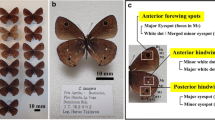Abstract
In this paper we describe a test for Nijhout's (1978, 1980a) hypothesis that the eyespot patterns on butterfly wings are the result of a threshold reaction of the epidermal cells to a concentration gradient of a diffusing degradable morphogen produced by focal cells at the centre of the future eyespot. The wings of the nymphalid butterfly, Bicyclus anynana, have a series of eyespots, each composed of a white pupil, a black disc and a gold outer ring. In earlier extirpation and transplantation experiments (Nijhout 1980a; French and Brakefield, 1995) it has been established that these eyespots are indeed organised around groups of signalling cells active during the first hours of pupal development. If these cells were to supply the positional information for eyespot formation in accordance with Nijhout's diffusion-degradation gradient model, then, when two foci are close together, the signals should sum, and this effect should be apparent in the detailed shape of the resulting pigment pattern. We give an equation for the form of the contours that would be obtained in this manner. We use this to test the morphogen gradient hypothesis on measurements of the outlines of fused eyespots obtained either by grafting focal cells close together, or by using a mutation (Spotty) that produces adjacent fused eyespots. The contours of the fused patterns were found to satisfy our equation, thus corroborating Nijhout's hypothesis to the extent possible with this particular type of experiment.
Similar content being viewed by others
REFERENCES
Abramowitz, M., and I. Stegun (1965). Handbook of Mathematical Functions. Dover, New York.
Bard, J. B. L., and V. French (1984). Butterfly wing patterns: how good a determining mechanism is the simple diffusion of a single morphogen? Journal of Embryology and Experimental Morphology 84: 225-274.
Blair, S. S., (1995). Compartments and appendage development in Drosophila. BioEssays 17: 299-309.
Brakefield, P. M., and V. French (1993). Butterfly wing patterns: Developmental Mechanisms and Evolutionary Change. Acta Biotheoretica 41: 447-468.
Brakefield, P. M., and V. French (1995). Eyespot Development on Butterfly Wings: The Epidermal Response to Damage. Developmental Biology 168: 98-111.
Brakefield, P.M., J. Gates, D. Keys, F. Kesbeke, P. J. Wijngaarden, A. Monteiro, V. French and S. B. Carroll (1996). Development, plasticity and evolution of butterfly eyespot patterns. Nature 384: 236-242.
Carroll, S. B., J. Gates, D. N. Keys, S. W. Paddock, G. E. F. Panganiban, J. E. Selegue and J. A. Williams (1994). Pattern Formation and Eyespot Determination in Butterfly Wings. Science 265: 109-113.
Crank, J., (1975). The Mathematics of Diffusion (2nd. ed.). Claredon Press, Oxford.
Driever, W., and C. Nusslein-Volhard (1988a). A gradient of bicoid protein in Drosophila embryos. Cell 54: 83-93.
Driever, W., and C. Nusslein-Volhard (1988b). The bicoid protein determines position in the Drosophila embryo in a concentration-dependent manner. Cell 54: 95-104.
Entchev, E. V., A. Schwabedissen and M. González-Gaiyán (2000). Gradient formation of the TGF-β Homolog Dpp. Cell 103: 981-991.
French, V., and P. M. Brakefield (1992). The development of eyespot patterns on butterfly wings: morphogen sources or sinks? Development 116: 103-109.
French, V., and P. M. Brakefield (1995). Eyespot Development on Butterfly Wings: The Focal Signal. Developmental Biology 168: 112-123.
Gurdon, J. B., P. Harger, A. Mitchell and P. Lemaire (1994). Activin signalling and response to a morphogen gradient. Nature 371: 487-492
Gurdon, J. B., A. Mitchell and D. Mahony (1995). Direct and continuous assessment by cells of their position in a morphogen gradient. Nature 376: 520-521.
Heemskerk, J., and S. DiNardo (1994). Drosophila hedgehog acts as a morphogen in cellular patterning. Cell 76: 449-460.
Katz, W. S., R. J. Hill, T. R. Clandinin and P. W. Sternberg (1995). Different levels of the C. elegans growth factor LIN-3 promote distinct vulval precursor fates. Cell 82: 297-307.
Lecuit, T., W. J. Brook, M. Ng, M. Calleja, H. Sun and S. M. Cohen (1996). Two distinct mechanisms for long-range patterning by Decapentaplegic in the Drosophila wing. Nature 381: 387-393.
Monteiro, A. F., P. M. Brakefield and V. French (1994). The evolutionary genetics and developmental basis of wing pattern variation in the butterfly Bicyclus anynana. Evolution 48: 1147-1157.
Monteiro, A., P. M. Brakefield and V. French (1997). The relationship between eyespot shape and wing shape in the butterfly Bicyclus anynana: a genetic and morphometrical approach. Journal of Evolutionary Biology 10: 787-802.
Nellen D., R. Burke, G. Struhl and K. Basler (1996). Direct and long-range action of a DPP morphogen gradient. Cell 85: 357-368.
Nijhout, H. F. (1978). Wing pattern formation in Lepidoptera: A model. Journal of Experimental Zoology 206: 119-136.
Nijhout, H. F. (1980a). Pattern formation on lepidopteran wings: Determination of an eyespot. Developmental Biology 80: 267-274.
Nijhout, H. F. (1980b). Ontogeny of the color pattern on the wings of Precis coenia (Lepidoptera: Nymphalidae). Developmental Biology 80: 275-288.
Nijhout, H. F. (1985). Cautery-induced colour patterns in Precis coenia (Lepidoptera: Nymphalidae). Journal of Embryology and Experimental Morphology 86: 191-203.
Nijhout, H. F. (1991). The Development and Evolution of Butterfly Wing Patterns. Smithsonian Institution Press, Washington.
Perrimon, N. (1995). Hedgehog and Beyond. Cell 80: 517-520.
Sprent, P. (1969). Models in regression and related topics. Methuen & Co Ltd, London.
Teleman, A. A. and S. M. Cohen (2000). Dpp gradient formation in the Drosophila wing imaginal disc. Cell 103: 971-980.
Zecca, M., K. Basler and G. Struhl (1995). Sequential organizing activities of engrailed, hedgehog and decapentaplegic in the Drosophila wing. Development 121: 2265-2278.
Author information
Authors and Affiliations
Rights and permissions
About this article
Cite this article
Monteiro, A., French, V., Smit, G. et al. Butterfly Eyespot Patterns: Evidence for Specification by a Morphogen Diffusion Gradient. Acta Biotheor 49, 77–88 (2001). https://doi.org/10.1023/A:1010226223287
Issue Date:
DOI: https://doi.org/10.1023/A:1010226223287




